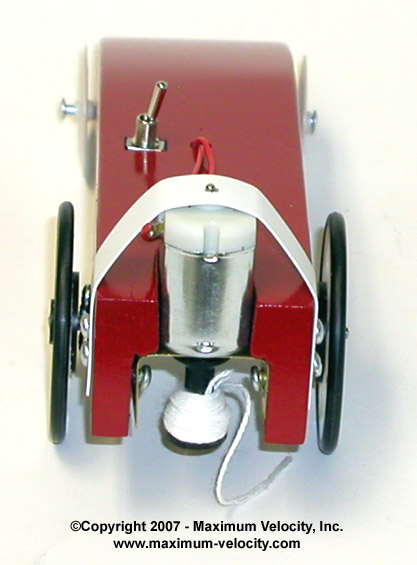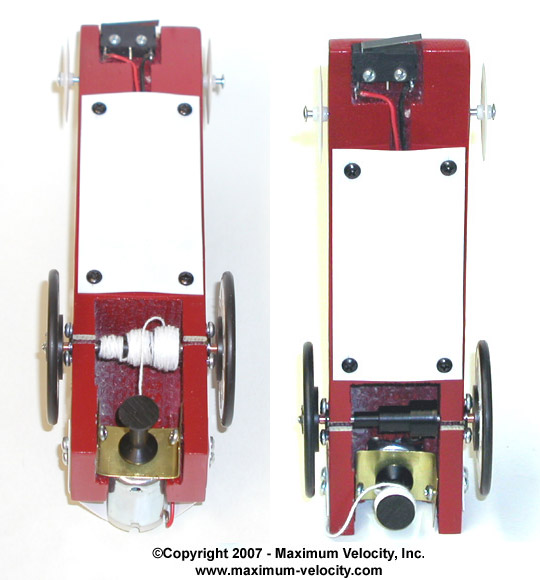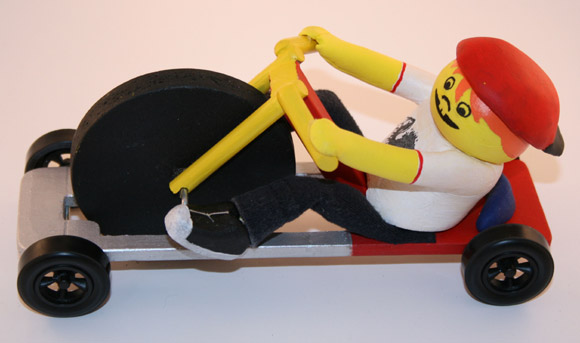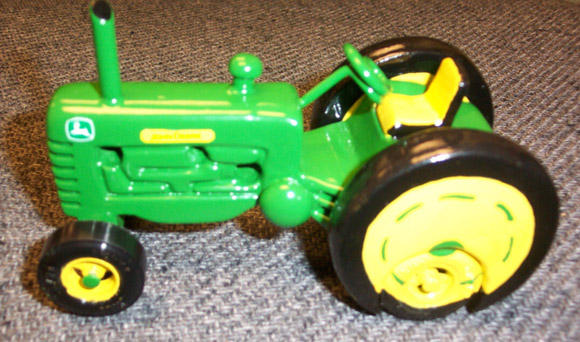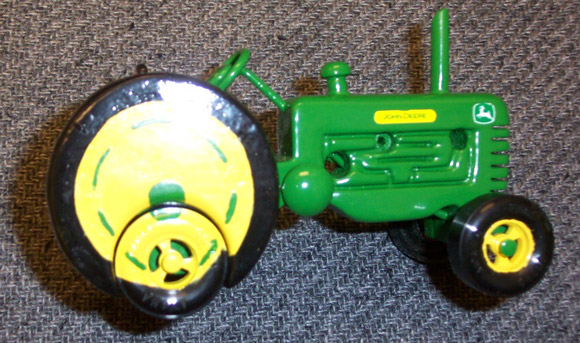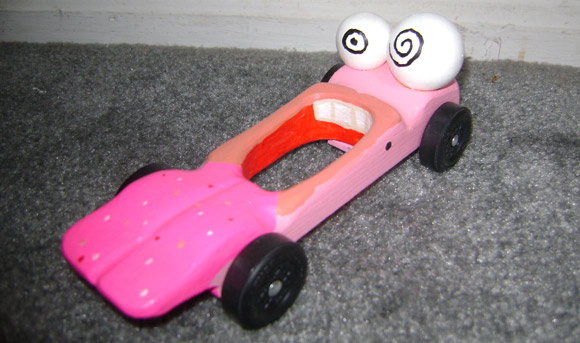– Feature Article – Top Fuel Cars: Direct Drive
– Pinewood Derby Car Showcase
– Q&A
Top Fuel Cars – Direct Drive
(The fifth in a series of articles on cars that “stretch the rules”)
Last summer I was searching the web for articles and Blogs relating to pinewood derby racing. Most of what I find is not particularly interesting, but occasionally I come across a real gem.
One of these gems was an article written by Eldon Goates, owner of Synthesis Engineering Services. Eldon decided to use PRO/Engineer design software to design a top-performing, direct-drive pinewood derby car for an outlaw race. After designing and building the car, he wrote an article describing the process for Pro/E magazine. You can find the entire article Here (.pdf file).
Although I do not have the sophisticated equipment available to Mr. Goates, I decided to make my own version of the car using a pinewood derby block. I do have a lathe to make a few of the key parts, but otherwise, the car was made with basic shop tools.
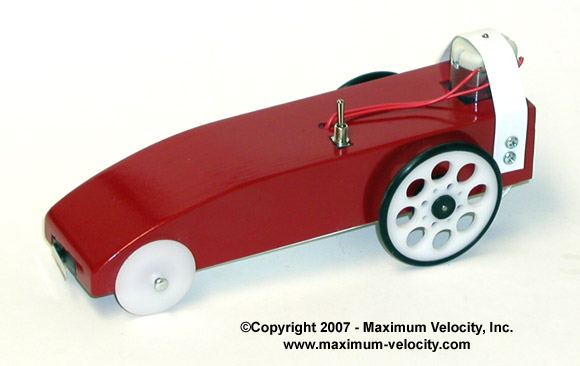
Car Design
The basic premise of the car is that a string is wound around the rear axle and is attached to a spool mounted onto a motor. When the motor is turned on, the string is wound onto the spool, causing the rear axle to rotate. The length of the string is set such that it runs out just as the car crosses the finish line. So, if the car was used on a track of a different length, the string would need to be adjusted.
The unique feature of this car design is the axle “transmission”. To understand how this works, think of a ten speed bicycle. When in a low gear (more torque, less speed), a smaller front “motor” sprocket (the motor is a pedaling human) and a larger rear “drive” sprocket (attached to the rear wheel) is used. But in a high gear (less torque, more speed), a larger front sprocket and a smaller rear sprocket are used.
Now adapting this concept to the direct drive car, at the starting line a low gear is wanted. This means that a smaller motor sprocket and a larger drive sprocket are needed. The smaller motor sprocket is simple; it is just the empty spool attached to the motor. The larger drive sprocket is accomplished by creating a larger rear axle (the right side of the transmission seen in Figure 4). Conversely, near the finish line, a high gear is desired – a larger motor sprocket and a smaller drive sprocket. This corresponds to the nearly full spool on the motor, and a smaller rear axle (left side of the transmission).
To make this work, the string is first wound around the smaller (left) portion of the transmission. Next, the middle portion is filled, followed by the larger portion. When in motion, these are, of course, unwind in the reverse order. The only trick is to make sure to rotate the rear wheel in reverse when winding. Otherwise the car will go backward!
Parts
First I needed to collect and/or manufacture the various parts. These included:
Basic block: This was drilled and milled to hold the parts.
Starting Pin Switch: I used a contact switch (part #275-016 at Radio Shack). It is normally on. When the car rests against the starting pin, the weight of the car closes the switch turning the motor off. Thus, when the pin drops, away it goes. This switch can be seen in Figure 2.
Kill Switch: A small toggle switch (part #275-624 at Radio Shack) that is used to turn the motor off when not in use. Just make sure to turn it on at the starting gate!
Batteries, 9V clips and cover: Two standard 9V batteries with 9V clips are located in the bottom of the car, hidden by a cover plate of styrene plastic (see Figure 4).
Motor: 12 VDC motor, I drove the motor at 18V for more power. This would eventually burn out the motor, but the on-time is so short that the motor doesn’t get a chance to overheat.
Motor Harness: The motor is mounted on a piece of brass, fastened to the block, and held down by a piece of styrene.
Axles: Front axles are our 4095-Speed Axles. The rear axle (one piece) is a piece of 3/32 steel rod.
Bearings: Two bearings are attached to the side of the car in the rear (I used small screws to catch the flange of the bearing). Thus, the entire rear assembly (wheels, axle, and axle transmission) rotate as a unit, supported by the bearings.
Bushings: The axle was a bit loose on the bearings, so I inserted two short pieces of copper tubing between the wheels and the bearings to keep the axle assembly from shifting left or right.
Wheels: The front wheels are white RS wheels from DerbyWorx. The rear wheels are two inch servo wheels from Pitsco. This larger size was needed so that the string spool would clear the center guide rail (it also helped performance). I had to make bushings of black Delrin so that the 3/32 inch axle rod would press fit into the wheels. You can see one of the bushings in Figure 1.
String Spool: This piece presses onto the shaft of the motor (Figures 3 and 4). It was machined from Delrin. A hole is drilled through the spool. The string is threaded through the hole, and then tied in place.
Axle Transmission: This piece was machined from Delrin (see Figure 4). It was then slid onto the rear axle and permanently attached with epoxy. There is a hole drilled into the transmission into which the tip of the string is inserted before winding.
Wiring: Light gage electronics wire. Positive side of the battery goes to the Kill Switch, then to the Starting Pin Switch, then to the motor. The negative wire goes to the motor. Batteries are wired in series.
String: I used some strong kite string. It tends to fray, so dental floss, or another type of non-fraying string would be better.
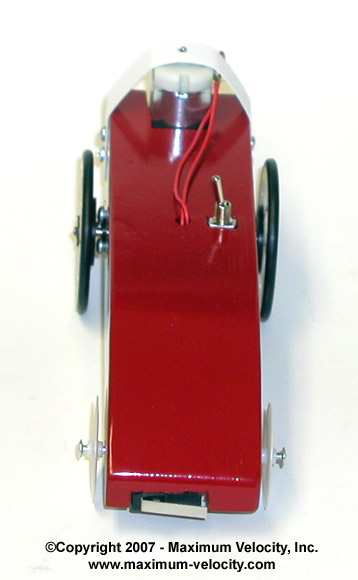
Figure 3 – Back of Car
Figure 4 – Bottom of Car
Left Photo – String is wound and car is ready to go
Right Photo – At end of run, string is wound around the motor spool
Performance
I ran this car on our 32 foot aluminum track, and it was faster than all of my propeller cars. Unfortunately, the car sat a little too high, so it would not go under the timer.
Against a fast gravity-powered car, it wins by nearly two track sections (about 14 feet). Here is a Quick Time Video of the direct-drive car racing against a fast gravity car.
Conclusion
This was a fun and challenging project. Certainly my car is not elegant like Eldon’s, but it got a lot of attention at our race in April 2007 – it confounded kids and parents alike. “How does it go so fast?,” was a common response.
By the way, if you build a direct drive car based on this design, or a different design, please send me an e-mail with a description and photos.
Pinewood Derby Car Showcase
Big Wheel: John White
I pushed the design envelope this year; after two years of mulling over an idea this is what I came up with. The two front wheels sit just off the track and are there to keep the car going straight. The center wheel rides down the middle of the track and works the kid’s legs. My goal was to make everyone at the race laugh. I wasn’t sure what was going to happen: would I qualify, would it make it down the track, run into another car, or just plain fall apart? Well — mission accomplished! He was just a peddlin’. It wasn’t fast by any means, but everyone enjoyed watching it race. And it won “Funniest Car”.
Awana Tractor: Doug Kile
I’m a leader with our local Awana program at Valley Community Church in Salinas California. Since Salinas is the “Salad Capital” of the world, you see many of these tractors in the fields around here.
Fast Talker: Frank Tonra
I made this car as the Pace Car for Pack 57 in Toms River. I found the idea for this one online and could not resist making it. Someone else came up with idea but it did not matter, they lined up to see the car and laughed all afternoon. I sent the car to the Districts and got the same result. What a joy to see their faces! It was well, worth the hours of sanding.
Editor’s Note: This car is based on the “Fast Talker” design by T. Dean White Creative.
Q&A
Our Pack rules state that new axle holes can be drilled but the spacing between the front and back wheels must be kept at 4.40 inches. Given this constraint, how far back should I place the rear axle? I am afraid that placing the rear axle to far back will cause the car to be unstable.
Generally, you can place the rear axles at 5/8 inch from the rear, and then place the front axles at 4.40 inches in front of the rear. As long as the weight is placed such that the final balance point is 3/4 to 1 inch in front of the rear axle, the car should be stable.
I was thinking about using 3/32 (.0937) inch music wire for a rear axle with BSA wheels. I plan on pushing the wire all the way through the car to create a solid rear axle. Do you think that 3/32 inch music wire will be too big?
If you are using DerbyWorx wheels (or similar) that have been reamed, then they will fine. But if you use wheels with the original bore size, some of the wheels may not work well, as the bore would be too small.
Want Answers?
Do you have a pinewood derby-related question? If so, e-mail us your question.We answer all questions by e-mail, but not every question will appear in the Q&A section of the newsletter.
Back Issues
Are you a new subscriber, or have you missed some of the previous newsletters? Don’t miss out; all of the issues for Volume 5 through Volume 17 are posted on our web site.
Newsletter Contributions
We welcome your contributions. If you would like to contribute an article, a web site review, a speed tip, or a pinewood derby memory, please e-mail us.
Subscription Information
The Pinewood Derby Times is a free e-newsletter focused on pinewood derby racing. It is published biweekly from October through March.
If you haven’t already done so, please forward this issue to your pinewood derby friends. But please don’t subscribe your friends. Let them decide for themselves. Thanks.
If this newsletter was forwarded to you, why not subscribe to receive this newsletter. There is no cost, and your e-mail address is safe, as we never sell or share our distribution list.
To subscribe, send a blank e-mail to
[email protected]
You will receive a confirmation e-mail. Reply to the confirmation e-mail and you will start receiving the Pinewood Derby Times with the next issue.
Randy Davis, Editor, Pinewood Derby Times
E-Mail: [email protected]
(C)2018, Maximum Velocity, Inc. All rights reserved. Please do not reprint or place this newsletter on your web site without explicit permission. However, if you like this newsletter we grant permission, and encourage you to e-mail it to a friend.
Maximum Velocity disclaims any personal loss or liability caused by utilization of any information presented in this newsletter.
The Pinewood Derby Times is not specific to, and is not affiliated with the Boy Scouts of America, YMCA, Awana, or any other organization.
(R)Maximum Velocity is a registered trademark of Maximum Velocity, Inc.
(R)Pinewood Derby is a registered trademarks of the Boys Scouts of America.
(R)Awana is a registered trademark of Awana Clubs International.
All other names are trademarks of their respective owners.

